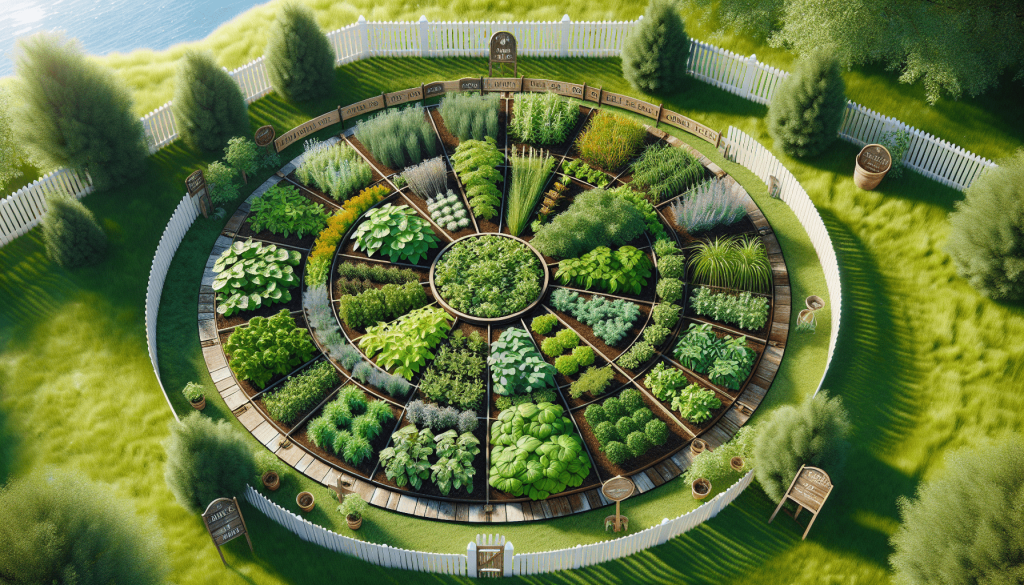This post may contain affiliate links. As an Amazon Associate, we may earn commissions from qualifying purchases.
Have you ever wondered how to create and maintain a herb wheel garden? If you’re like many of us, the idea of a picturesque garden filled with aromatic herbs laid out in a visually appealing circular pattern is downright enchanting. Whether you’re a seasoned gardener or a complete novice, this guide will walk you through each step of creating and maintaining your own herb wheel garden.

Introduction to Herb Wheel Gardens
Herb wheel gardens combine functionality with aesthetic appeal. They’re designed to maximize the use of space while providing a beautiful focal point in your garden. Imagine stepping outside your door and picking fresh basil for your pasta, mint for your mojito, or thyme for your roast chicken. That’s the magic a herb wheel garden can bring to your everyday life!
What is a Herb Wheel Garden?
A herb wheel garden is a circular garden divided into segments or “spokes,” each containing different types of herbs. This layout not only looks stunning but also makes it easier to manage and harvest the herbs. It can be as intricate or as simple as you like, depending on your available space and gardening skills.
Why Choose a Herb Wheel Garden?
Creating a herb wheel garden allows you to grow a variety of herbs in a compact space, making them easy to access and care for. Additionally, the design enhances the beauty of your garden, serving as a natural centerpiece. You’ll also benefit from the herbs’ fresh aromas and flavors, making your cooking and living spaces more enjoyable.
Planning Your Herb Wheel Garden
Before getting your hands dirty, you’ll need a bit of planning. The planning phase is crucial to ensure that your herb wheel garden meets your needs and suits your space.
Selecting the Location
Your first task is to choose the right location. Herbs generally need a good amount of sunlight—around 6-8 hours per day. If your garden has a particular spot that fits this criterion, great! If not, you may need to adjust your garden layout or perhaps even trim some trees to make it work.
Determining the Size
Next, think about the size of your herb wheel. This depends on your available space and the number of herbs you wish to grow. A smaller wheel with a diameter of about 3-5 feet can house 5-6 different herbs comfortably. However, if you have a larger space, you can opt for a bigger design with more segments.
Consider how much space each herb needs to grow both above and below ground. Here’s a simple table to guide you on the spacing requirements:
| Herb | Space Needed Above Ground | Space Needed Below Ground |
|---|---|---|
| Basil | 12-18 inches | 6-8 inches |
| Mint | 12-24 inches | 10-12 inches |
| Rosemary | 24-36 inches | 12-18 inches |
| Thyme | 12-18 inches | 6-8 inches |
| Oregano | 12-18 inches | 8-10 inches |
| Parsley | 9-12 inches | 6-8 inches |
Choosing Your Herbs
The types of herbs you choose should reflect your culinary preferences, as well as the growing conditions in your area. Common choices include basil, mint, rosemary, thyme, oregano, and parsley. However, feel free to include more exotic options like lemon balm, cilantro, or chives if they tickle your fancy.
Soil Preparation
Good soil is vital for the health of your herbs. Ideally, your soil should be rich in organic matter, well-draining, and slightly alkaline. You can improve your soil quality by adding compost or well-rotted manure. Make sure to weed the area thoroughly and break up any compacted soil before planting.
Building Your Herb Wheel Garden
With the planning phase out of the way, it’s time to roll up your sleeves and get to work. This is the part where your dream starts to take shape.
Marking the Area
Start by marking the perimeter of your circle with string or chalk. Measure your desired diameter and place a stake in the center. Attach a string to the stake and use it to draw a perfect circle by walking around the stake and letting the string guide your chalk or marking tool.
Dividing the Circle Into Segments
Divide your circle into equal segments, much like slicing a pizza. You can use string to mark these divisions, running from the center stake to the outer edge. This creates the distinct “wheel” appearance.
Installing Edging
Edging not only enhances the look of your herb wheel but also helps to keep the soil and plants contained. You can use bricks, stones, or even wooden planks as edging materials. Just make sure they’re stable and firmly in place.
Preparing the Soil
Once your edging is in place, prepare the individual segments by adding compost and tilling the soil. This step ensures that each section is nutrient-rich and ready for planting.
Planting Your Herbs
Now comes the fun part—planting your herbs! This step is where your garden truly comes to life.
Planting Tips and Techniques
- Read the Planting Instructions: Each herb has its own set of requirements, so be sure to read the planting instructions carefully.
- Planting Depth: Generally, you should plant herbs at the same depth they were in their containers. Dig holes accordingly.
- Watering After Planting: Water your herbs immediately after planting to help them settle into their new home.
- Mulching: A thin layer of mulch can help retain soil moisture and keep weeds at bay. However, avoid thick layers as they may restrict air flow.
Ideal Planting Time
Spring is usually the best time to plant your herbs. However, the exact timing can vary depending on your location and climate. Plant after the last frost date in your area to give your herbs the best start.

Caring for Your Herb Wheel Garden
Once your herbs are planted, they’ll need regular care and attention to thrive. Your efforts will be rewarded with a lush, productive garden.
Watering
Herbs generally prefer well-drained soil and do not like to sit in water. Watering deeply but infrequently encourages deep root growth. In hot weather, you may need to water more frequently. However, always check the soil moisture before watering to avoid overwatering.
Fertilizing
Most herbs do not require heavy feeding. A light application of a balanced fertilizer once or twice during the growing season should suffice. Organic options like compost tea or fish emulsion are excellent choices.
Pruning and Harvesting
Pruning helps to maintain the shape of your herbs and encourages healthier growth. Regularly pinch back the tips of your herbs to promote bushier plants. When harvesting, avoid taking more than 1/3 of the plant at a time to allow for continued growth.
Pest Control
Herbs can attract various pests such as aphids, spider mites, and caterpillars. Regularly inspect your plants for signs of infestation and take action if needed. Natural remedies like neem oil or insecticidal soap can be effective against many common pests.
Seasonal Maintenance
Your herb wheel garden will need different types of care as the seasons change. Being proactive can help your garden flourish year-round.
Spring
Spring is a time of growth and renewal. This is the perfect season to plant new herbs, refresh the soil with compost, and remove any dead plants or debris. Regularly check for emerging pests or diseases and tackle them early.
Summer
Summer usually requires a bit more attention to watering. Mulching can help retain soil moisture and keep the roots cool. Continue harvesting regularly to encourage new growth and maintain the shape of your herbs.
Fall
In the fall, you might want to start pruning back your herbs and preparing them for the colder months. Some herbs may go dormant, while others can be moved indoors or covered to protect them from frost. Adding a layer of mulch can also help insulate the soil.
Winter
Winter is a time to let your garden rest. However, there are still some tasks you can perform. Protect any perennial herbs with cloches or row covers. Monitor indoor herbs for water needs and pest issues.
Troubleshooting Common Issues
Every garden has its challenges, and herb wheel gardens are no exception. Knowing how to troubleshoot common issues can save you a lot of headaches.
Overwatering and Root Rot
One common issue is overwatering, which can lead to root rot. Always check the soil moisture before watering and ensure good drainage. If you notice yellowing leaves or a rotten smell, you may need to reduce your watering frequency.
Pest Infestation
Keep an eye out for common pests like aphids or spider mites. You can use a mixture of water and mild dish soap to wash off many pests. For more severe infestations, neem oil or insecticidal soaps can be effective.
Poor Growth or Health
If your herbs are not thriving, poor soil quality could be the culprit. Conduct a soil test to check for nutrient deficiencies or pH imbalances. Amending your soil with compost or organic matter can often improve the situation.
Conclusion
Creating and maintaining a herb wheel garden can be an immensely rewarding experience. Not only do you get to enjoy the fresh flavors and aromas of your culinary herbs, but you also get to enhance the beauty of your garden. With some planning, a bit of elbow grease, and regular care, your herb wheel garden will thrive for years to come.
So why wait? Your lush, aromatic, and visually captivating herb wheel garden is just a few steps away. Happy gardening!








